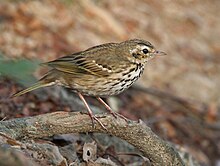| Motacillidae | |
|---|---|
 | |
| White-browed wagtail (Motacilla maderaspatensis) | |
| Scientific classification | |
| Domain: | Eukaryota |
| Kingdom: | Animalia |
| Phylum: | Chordata |
| Class: | Aves |
| Order: | Passeriformes |
| Superfamily: | Passeroidea |
| Family: | Motacillidae Horsfield, 1821 |
| Genera | |
The wagtails, longclaws, and pipits are a family, Motacillidae, of small passerine birds with medium to long tails. Around 70 species occur in five genera. The longclaws are entirely restricted to the Afrotropics, and the wagtails are predominantly found in Europe, Africa, and Asia, with two species migrating and breeding in Alaska. The pipits have the most cosmopolitan distribution, being found mostly in the Old World, but occurring also in the Americas and oceanic islands such as New Zealand and the Falklands. Two African species, the yellow-breasted pipit and Sharpe's longclaw, are sometimes placed in a separate seventh genus, Hemimacronyx , which is closely related to the longclaws. [1]
Contents
Most motacillids are ground-feeding insectivores [2] of slightly open country. They occupy almost all available habitats, from the shore to high mountains. Wagtails prefer wetter habitats than the pipits. A few species use forests, including the forest wagtail, and other species use forested mountain streams, such as the grey wagtail or the mountain wagtail.
Motacillids take a wide range of invertebrate prey: insects are the most commonly taken, but also including spiders, worms, and small aquatic molluscs and arthropods. All species seem to be fairly catholic in their diets, and the most commonly taken prey for any particular species or population usually reflects local availability.
With the exception of the forest wagtail, they nest on the ground, [2] laying up to six speckled eggs.













